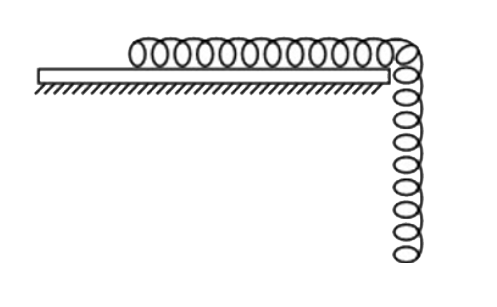A chain (A) of length L is coiled up on the edge of a table. Another identical chain (B) is placed straight on the table as shown. A very small length of both the chains is pushed off the edge and it starts falling under gravity. There is no friction

(a) Find the acceleration of the chain B at the instant L2 length of it is hanging. Assume no kinks in the chain so that the entire chain moves with same speed.
(b) For chain A assume that velocity of each element remains zero until it is jerked into motion with a velocity equal to that of the falling section. Find acceleration of the hanging section at the instant a length l0 has slipped off the table and its speed is known to be v0 at the instant.
The correct Answer is:(a) g2
(b) g−v20l0
Step by step video, text & image solution for A chain (A) of length L is coiled up on the edge of a table. Another identical chain (B) is placed straight on the table as shown. A very small length of both the chains is pushed off the edge and it starts falling under gravity. There is no friction (a) Find the acceleration of the chain B at the instant L_(2) length of it is hanging. Assume no kinks in the chain so that the entire chain moves with same speed. (b) For chain A assume that velocity of each element remains zero until it is jerked into motion with a velocity equal to that of the falling section. Find acceleration of the hanging section at the instant a length l_(0) has slipped off the table and its speed is known to be v_(0) at the instant. by Physics experts to help you in doubts & scoring excellent marks in Class 11 exams.
Topper's Solved these Questions
Similar Questions
A uniform chain of length l and mass m lies on a smooth table. A very small part of this chain hangs from the table. It begins to fall under the weight of hanging part. Find the velocity of chain when the length of hanging part becomes y.
View SolutionA uniform chain of length l begins to fall with a velocity v on the table. Find the thrust force exerted by the chain on the table.
View Solution
Knowledge Check
- Question 1 - Select One or More
A uniform chain of length L lies on a smooth horizontal table with its length perpendicular to the edge of the table and a small portion of the chain is hanging over the edge. The chain starts sliding due to the weight of the hanging part
AThe acceleration of the chain is (gx/L), where x is the length of the hanging part of chain.BThe acceleration of the chain is (g/L)(L−x), where x is the length of hanging part of chain.CThe velocity of the chain is x√gL, where x is the length of hanging part of chain.DThe velocity of the chain is (L−x)√gL, where x is the length of hanging part of chain. - Question 2 - Select One
A chain of mass M is placed on a smooth table with 1/n of its length L hanging over the edge. The work done in pulling the hanging portion of the chain back to the surface of the table is:
AMgL/nBMgL/2nCMgL/n2DMgL/2n2 - Question 3 - Select One
A uniform chain of length l is placed on rough table with length l/n (where n>1) , hanging over the edge. If the chain just begins to slide off the table by itself from this position, the coefficient of friction between the chain and the table is
A1/nB1/(n−1)C1/(n+1)D(n−1)/(n+1)
A chain of mass m and length L is over hanging , from the edge of a smooth, horizontal table such that , 3/4th of its length is lying on , the table .The work done in pulling the chain completely , on to the table is
View SolutionA chain of length L supported at the upper end is hanging vertically. It is released. Determine the interval of time it takes the chain to pass a point 2L below the point of support, if all of the chain is a freely falling body.
View SolutionA chain of length L and mass M is held on a frictionless table with (1/n)th of its length hanging over the edge. When the chain is released, find the velocity of chain while leaving the table.
 View Solution
View SolutionA homogoneous chain of length L lies on a table. The coefficient of friction between the chain and the table is μ. The maximum length which can hang over the table in equilibrium is
View SolutionA chain is placed on a rough table, partially hanging, as shown in the figure. The coefficient of static friction between the chain and the table is μ = 0.4. If the maximum possible length of the hanging part is x and the length of the chain is L, then what is the value of Lx?
 View Solution
View Solution
